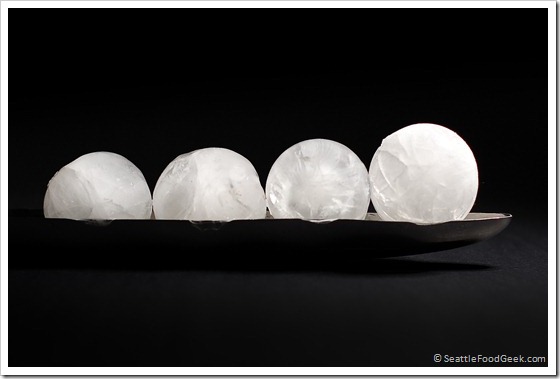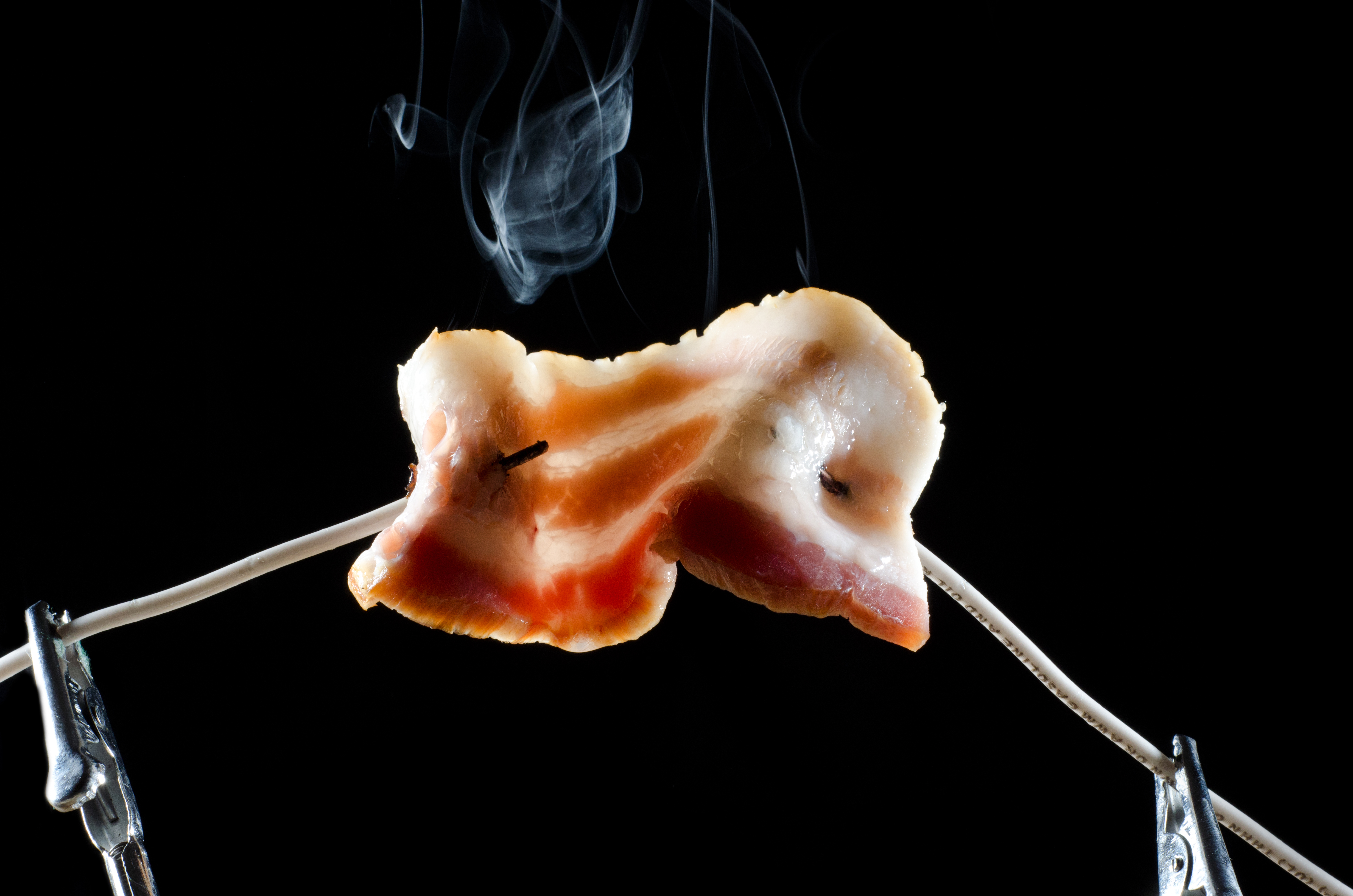
The ball on the far left was made from plain tap water – never boiled, never filtered. The 2nd ball from the left was made from tap water which I boiled for 3 minutes, then cooled, then boiled again. The 3rd ball was made from water I filtered through my Brita then boiled once. The ball on the far right was made from filtered, double-boiled water.
Can you see the difference in clarity? Yeah, me neither.
My goal was to make clear ice – that is, ice that is totally transparent without any haziness or white fissures. I know that commercial ice makers use fancy processes like upside down freezing, but several websites propose that you can make your own clear ice just by boiling (or double boiling) water before freezing. I put this to the test, and as you can see, my results were less than stellar.
The complication may have to do with the ice ball molds I was using. The molds are sealed, so it’s possible that some gasses (or evil spirits) weren’t able to escape during the freezing process. I’ll try again with regular cubes or blocks, but for now, I’m a little pissed that I’ll have to chill my morning gin with cloudy ice.

Have you tried vibrating the ice during the freezing process?
The idea has occured to me, but I haven’t yet been willing to sacrifice my Sonicare 🙂
I’m going to give this a try with my 4 stage R.O. unit. I’m not sure, but can it possibly be contaminants,minerals pipe whether pvc or metal and other things in the water that might attribute to the cloudiness? I use my R.O. unit to prep the water for two saltwater systems I have. Other than that the only other thing that makes sense is to somehow form it in layers.
Wouldn’t vibration cause air bubbles that could ultimately get trapped when the water reaches the actual freezing process? Kate, are you referring to vibration from underneath whatever medium the ice is in?
One of the experiments that I’m trying right now is making ice under vacuum pressure. I don’t think my foodsaver will create enough of a vacuum to see noticable results, but I’ve got a friend with a cryovac and I’ll bribe him to do the test for me.
I’ve heard all kinds of theories about the cloudiness – trapped gasses, minerals, layers formed by the freezing process… but so far, I haven’t seen an at-home solution that seems to work.
I’m kind of thinking something along the lines of how an icycle forms by water dripping down the icycle never trapping air between water and icycle leaving you with almost 100% transparency. Doesn’t hurt that’s it pure water either I guess. I’m curious to see how that turns out for you Scott. I’ll be checking in.
I’ve never read a satisfying scientific explanation for this. People talk about “impurities,” but plenty of well-ordered crystals form with mixed solutions (some things ONLY crystallize in the presence of added salts). Trapped gases make a bit more sense, I guess. Have you thought about degassing with a suction flask? Seems like what you are going for with the foodsaver.
I wonder what happens if you build the ice up in very thin layers (drop-by-drop into a cube tray was what I first thought of, but perhaps pour-by-pour into a single slot in a cube tray would show some change in the right direction without being tricky to set up.)
You. Blow. My. Mind.
Have you tried distilled water? I’d imaging if start with really really cold distilled water, close to freezing, then put it in your fridge it might work. You’ll likely need a slow cooling process otherwise, hopefully starting with near freezing water and then cooling it will do the trick.
What might help is putting the water in the mold while hot – there are fewer gases then so you should be able to get clearer ice. So essentially boil then immediately fill the mold and place it in the freezer.
@Matt I’ll try distilled water and cool it before freezing.
@Caitlin – I did actually put the water in the molds while hot – straight out of the boiling pot with a giant syringe, then into the mold. But, the mold was sealed so that air couldn’t escape. Maybe that was the problem?
more fascinating to me than the solution to the clear ice is the fleeting Preston Singletary you created in the photo…kudos
foodsaver will certainly make enough vacuum to make it an interesting experiment… get one of the marinating canisters and place an ice mold inside.
Unfortunately, the vacuum approach sucked (pun intended). I got even more trapped air in the frozen ice than at normal atmospheric pressure. Maybe a positive pressure would make a difference?
I’ll keep trying and report back.
Scott, I’d say that not sealing it would help – you want to let the air go out into the main portion of your freezer rather than partitioning back into the water as it cools. The faster you can freeze it, the less likely it will partition back into the water as well.
i think its awesome that you invested the time to experiment with this. Keep the interesting topics coming!
I remember freezing large blocks of ice while I was a kid for fun. The one thing I remember for sure was that the ice near the edge was absolutely clear while the very center was cloudy. I suspect that it was because the top freezes before the middle and traps the air inside. I believe the solution is to break the this layer of ice that forms on top every once in awhile to ensure that it is the last part that freezes. It makes sense because the few time I remember large blocks of clear ice was when it was moving water.
I also believe more pressure would work. I remember seeing a documentary that took place in the arctic. They showed a huge iceberg that was absolutely clear. They said it formed at a certain pressure and temperature which is why is was clear. This was with ocean water as well which I’m sure has far more impurities then your tap water.
Dang it! Now I want to do this. I’ll let you know if I succeed.
How about distilled water as that apparently has all the impurities removed.
Some research of interest
http://books.google.com/books?id=NRcpAAAAYAAJ&pg=PA352&lpg=PA352&dq=high+pressure+clear+ice&source=bl&ots=Kfo8JUbWqv&sig=G0gInlj3HHP8WellNcj0w1ceEhE&hl=en&ei=nbuqTPyxHo6gsQOu6YTEAw&sa=X&oi=book_result&ct=result&resnum=3&sqi=2&ved=0CB0Q6AEwAg
“…clear ice can be made with raw water using greater air pressure.”
Having a background in tech support for a water filtration company in the past, I can say with some authority that you need to use water from a reverse osmosis system to get clear ice. Distilled water might also do the job.
Hey Scott, would you happen to know how cold your freezer is? I’m pretty convinced now that freezing slowly is the key. So if it’s possible try to freeze closer to 32.
While researching I found this device that makes perfect ice spheres. However you need to start with a large cube of clear ice so it still doesn’t solve the problem.
http://www.japantrendshop.com/ice-ball-mold-for-perfect-ice-spheres-p-244.html
I saw an interesting method online. In short, fill an igloo cooler that can fit in your freezer (top off). Freeze until it behind to look cloudy at the bottom of said cooler. Remove it from the freezer and invert. In a few minutes your giant ice cube will drop out. Most of it will be Crystal clear. The very bottom will be a bit slushy. Cut it off. Voila – Crystal clear ice.
The theory behind this is a’top-down’ freeze as compared to an outside-in, which traps the impurities in the center of the cube. The impurities migrate down as the ice forms above and you end the process while it’s still easy to separate the cloudy portion
The downside is that your freezer will probably not be able to hold much else while you’re doing this
We have provided information like salon prices and different related memberships, gift cards, salon hours etc. in our website which you can use, the prices given here are taken from the official website and given to you by our team. will come which you can see
Visit Our Website: https://salon-price.com/